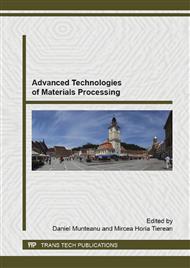p.236
p.242
p.254
p.261
p.271
p.282
p.288
p.293
p.303
Studies Regarding the Influence on the Surface Roughness Material of the Cutting Regime during the Milling Processing
Abstract:
The aim of the present paper is to establish the optimal parameter values of the cutting regime of a milling process. The paper presents a study regarding the influence of the cutting parameters on the surface roughness of the material and also on the vibration generated by their combinations, during a processing by milling. The studies are made on samples made from S355 JR steel with a metal milling machine FUS 25, which is used also for the experiments. The samples dimensions are 210x150x16mm. For the experiments there was used a cylindrical - frontal milling tool, with 32mm diameter and 10 tooth. Basic parameters of milling processing of materials we have considered in this paper are: feed rate [mm/min]; cutting speed RPM [rot/min]; depth of cut [mm]. For each of this parameters three levels were envisaged. For a 100% accurate experiment results at least 27 experiments must be done. Using an L9 orthogonal array, the number of experiments is reduced to nine and the accurate of the method is around 99.96%. The optimal process parameters values are obtained using Taguchi method considering three situations. In the first case the goal is to get only a fine roughness for the sample. The second studied case is focused on finding a low level for the vibration generated during the milling process. The aim of the last study is to find a fine roughness and also a low level of vibration for the process. The analysis of variance (ANOVA) is applied, in all cases, in order to estimate the error variance and to rank the process parameters according to their importance.
Info:
Periodical:
Pages:
271-281
Citation:
Online since:
October 2015
Authors:
Keywords:
Price:
Сopyright:
© 2015 Trans Tech Publications Ltd. All Rights Reserved
Share:
Citation:


